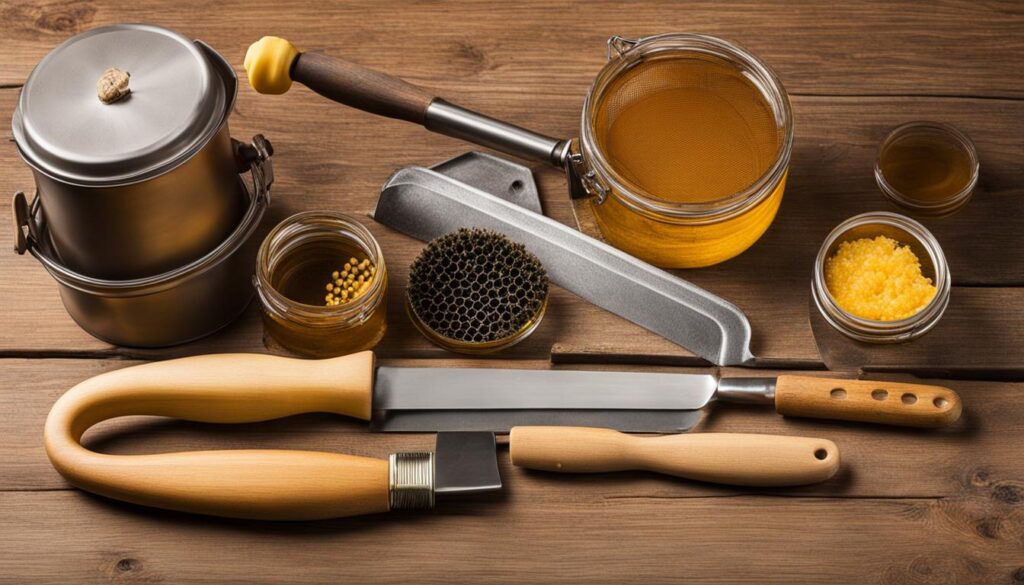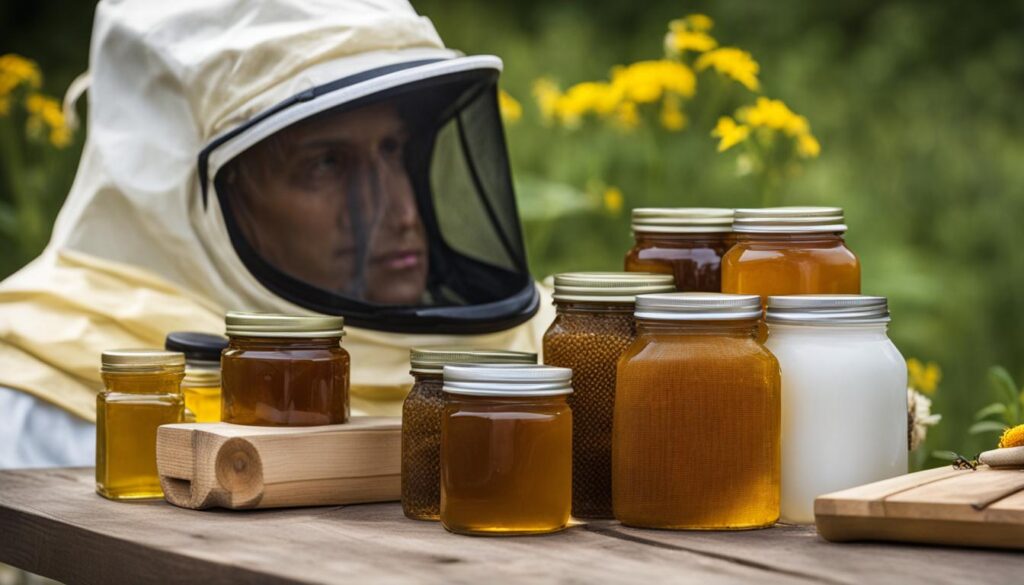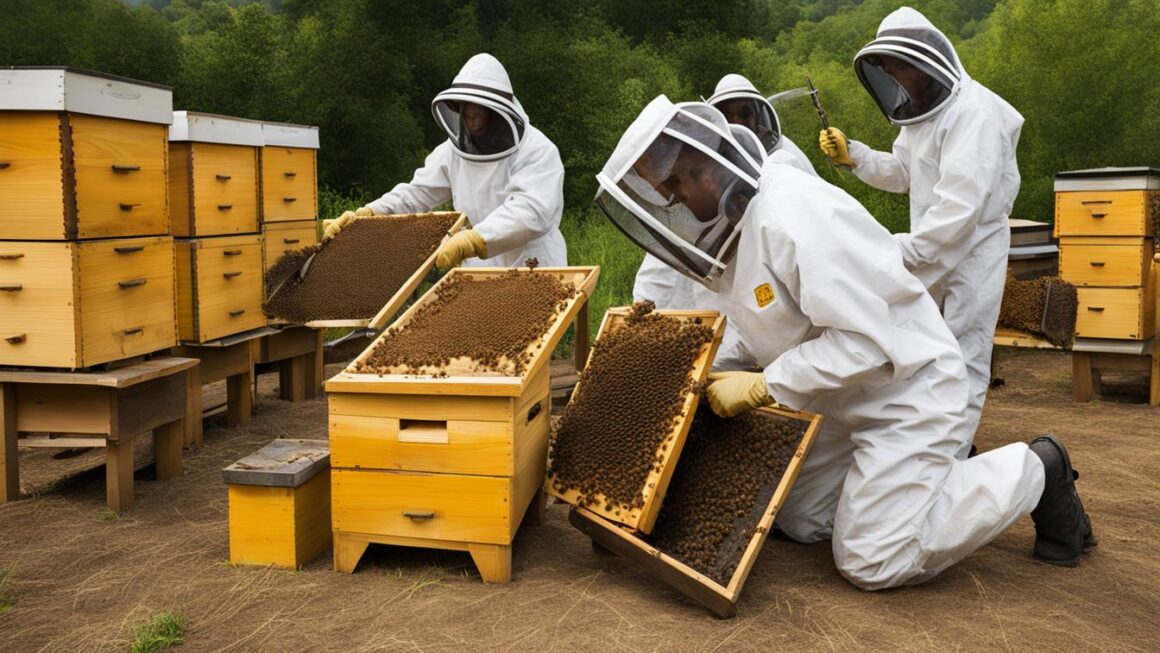Starting your own beekeeping journey can be an exciting and rewarding experience. However, it’s essential to have the right equipment to ensure the success and well-being of your bees. In this article, we will explore the must-have beekeeping equipment, including hives, protective gear, tools, and more, that every beekeeper should have in their apiary.
Key Takeaways:
- Investing in essential beekeeping equipment is crucial for the success of your apiary.
- Hives, including top bar and Langstroth hives, provide a home for your bees and come in various designs and sizes.
- Protective gear, such as bee veils and suits, keeps you safe from bee stings during hive inspections.
- Tools like hive tools, bee brushes, and honey extractors help with hive management and honey extraction.
- A smoker is a valuable tool to calm bees and ease access to the hive.
By ensuring you have the right beekeeping equipment, you can create a thriving apiary and enjoy the fruits of your labor while keeping yourself and your bees safe. Let’s dive into the details of each essential equipment and the role they play in your beekeeping journey.
Hives: Choosing the Right Home for Your Bees
When it comes to beekeeping, hives are an essential piece of equipment for housing your bees. There are two main types of hives commonly used by beekeepers: top bar hives and Langstroth hives. Each type has its own unique features and considerations, so it’s important to choose the right home for your buzzing residents.
Top bar hives are a popular choice for beekeepers who prefer a more natural and sustainable approach. These hives consist of a long, horizontal top bar where bees build their comb. They have a simple design and are easier to manage for beginners. On the other hand, Langstroth hives are the traditional rectangular boxes with vertically stacked frames. They are more standardized and widely used in commercial beekeeping due to their versatility and ease of expansion.
When selecting a hive, there are a few factors to consider. First, think about the hive design that suits your beekeeping goals and preferences. Think about the frame size as well, whether you prefer 8 or 10 frames per hive. Additionally, some beekeepers find it beneficial to have a hive with an observation window, which allows for easier monitoring of the hive without disturbing the bees. Ultimately, the choice of hive will depend on your personal preferences and the specific needs of your beekeeping operation.
| Hive Type | Pros | Cons |
|---|---|---|
| Top Bar Hives | Simple design, sustainable approach, beginner-friendly | Less honey production, limited expandability |
| Langstroth Hives | Versatile, widely used, standardized equipment | Heavier when full of honey, more complex management |
Remember, the choice of hive is just the beginning of your beekeeping journey. It’s important to continue learning and adapting as you gain experience. With the right hive and the necessary beekeeping equipment, you’ll be well on your way to establishing a thriving apiary.
Bees: Acquiring the Buzzing Residents for Your Hive
When it comes to beekeeping, acquiring the right bees is essential for the success of your hive. There are two main methods of obtaining bees: buying packaged bees or catching a swarm. Each method has its own advantages and considerations, so it’s important to understand the differences before making a decision.
Buying packaged bees is a popular option for many beekeepers. Packaged bees are typically sold in a box with a queen and a certain number of worker bees. This ready-to-go colony allows beekeepers to establish a new hive quickly and easily. It’s important to source packaged bees from reputable suppliers to ensure the health and quality of the colony.
Catching a swarm is another way to acquire bees for your hive. Swarming is a natural process in which a queen bee and a portion of her worker bees leave their original hive and form a new colony. Beekeepers can catch swarms by providing suitable bait hives or by removing swarms from locations such as trees or buildings. Catching a swarm allows beekeepers to start with bees that are already adapted to the local environment.
Before introducing new bees to your hive, it’s crucial to research and understand the process of integration. Proper introduction techniques and monitoring can help ensure a smooth transition and reduce the risk of conflicts between new and existing bees in the hive.
| Method | Advantages | Considerations |
|---|---|---|
| Buying Packaged Bees | – Ready-to-go colony – Established queen – Easier to control and monitor |
– Cost of purchasing bees – Quality and health of packaged bees – Transporting and introducing bees to the hive |
| Catching a Swarm | – Bees adapted to local environment – No cost for acquiring bees |
– Time and effort required to catch a swarm – Finding a suitable swarm location – Swarm may not survive or thrive |
Protective Gear: Keeping Yourself Safe During Beekeeping
Beekeeping can be a fulfilling and rewarding hobby, but it’s important to remember that working with bees comes with certain risks. That’s why it’s crucial to invest in the right protective gear to keep yourself safe from bee stings and potential allergic reactions. The key pieces of protective gear every beekeeper should have include a bee suit, bee veil, and bee smoker.
Bee Suit
A bee suit is an essential piece of protective clothing that covers your body from head to toe. It consists of a full-body jumpsuit made of thick cotton or polyester material that is designed to protect you from bee stings. The suit should fit snugly to prevent any gaps where bees can enter. It typically comes with elastic cuffs and ankle closures to ensure a tight seal. Some bee suits also come with built-in gloves, but it’s recommended to wear separate gloves for better dexterity and protection.
Bee Veil
A bee veil is a fine mesh hood that attaches to the bee suit and covers your head and neck. It provides a barrier between you and the bees, preventing them from coming into contact with your face and scalp. The veil should fit securely and have an elastic band that keeps it in place. Look for a veil with good visibility and ventilation to ensure comfort while working with the bees.
Bee Smoker
A bee smoker is a tool used to calm bees during hive inspections. It produces smoke that masks the bees’ alarm pheromones and triggers them to gorge on honey, making them less aggressive. A bee smoker typically consists of a metal canister with a bellows that blows air through a nozzle, creating smoke. It’s important to use dry, cool smoke to avoid injuring the bees or causing damage to the hive. The smoke should be directed towards the entrance of the hive and towards the bees, but not directly onto them.
Investing in high-quality protective gear is essential for beekeepers of all levels of experience. It not only keeps you safe but also allows you to work with your bees more confidently and effectively. Remember to regularly inspect and maintain your gear to ensure its effectiveness and durability.
“Beekeeping can be a fulfilling and rewarding hobby, but it’s important to remember that working with bees comes with certain risks.”
Tools of the Trade: Essential Equipment for Beekeeping
When it comes to beekeeping, having the right tools can make all the difference in managing your hives effectively. Here are some essential beekeeping tools that every beekeeper should have:
Hive Tool
The hive tool is a versatile tool that is used for prying open hives, loosening frames, and scraping off excess propolis. It is an essential tool for any beekeeper and comes in different shapes and sizes. The hive tool makes it easier to inspect the hive and manipulate frames without causing any damage to the delicate honeycomb.
Bee Brush
A bee brush is used to gently remove bees from frames during inspections. It has soft bristles that allow you to brush the bees off without harming them. Bee brushes are particularly useful when you need to access specific parts of the hive or when you need to remove bees from frames before harvesting honey.
Uncapping Tool
When it’s time to extract honey from the frames, an uncapping tool is essential. It is used to remove the wax caps from the honeycomb cells, allowing the honey to be extracted. There are different types of uncapping tools available, including electric uncapping knives and manual uncapping scratchers. Choose the tool that suits your needs and preferences.
Honey Extractor
A honey extractor is a must-have tool for any beekeeper who wants to harvest honey from their hives. It is used to spin the frames and extract the honey without damaging the comb. There are different types of honey extractors available, including manual and electric ones. Consider the size of your operation and your budget when choosing a honey extractor.
Having these essential tools on hand will not only make your beekeeping tasks easier but also ensure that you can manage your hives efficiently. Remember to always handle your tools with care and maintain them properly to prolong their lifespan. Happy beekeeping!

Smoker: Calming the Bees for Easy Hive Access
Beekeepers use smoke as a valuable tool to calm bees during hive inspections and management tasks. The smoke masks the bees’ pheromones and reduces their defensive reactions, making it easier for beekeepers to access the hive without causing unnecessary stress or aggression. A well-calibrated smoker can help create a peaceful environment for both the beekeeper and the bees.
To create a smoker, you can use easily accessible materials such as wood chips, small twigs, leaves, or pine needles. These materials are burned in the smoker to produce the smoke needed for beekeeping activities. It’s a cost-effective and efficient method that has been used by beekeepers for generations.
When using a smoker, it’s important to remember a few key tips:
- Light the smoker well in advance, allowing it to produce a steady stream of smoke before opening the hive.
- Use the smoker sparingly – a little smoke goes a long way. Too much smoke can agitate the bees.
- Direct the smoke gently towards the entrance of the hive, allowing it to drift through the hive and calm the bees.
By using a smoker properly, beekeepers can ensure a smoother and less stressful experience when working with their hives. It’s an essential tool in the beekeeper’s arsenal and one that should not be overlooked.
Hive Stand: Elevating Your Hives for Better Management
When it comes to beekeeping, having a hive stand is a practical and beneficial investment. The hive stand serves as a sturdy base for your hives, elevating them off the ground for easier management and inspection. By lifting the hives, you reduce strain on your back and knees, making it more comfortable to work with your bees.
Not only does a hive stand provide ergonomic advantages, but it also helps protect your hives from potential threats. Placing the hives on a stand reduces the risk of pests or critters disturbing the colonies. It also creates a barrier that discourages grass growth, which can hinder hive entrances.
Creating a hive stand is a straightforward process. You can make a simple and cost-effective stand using cinder blocks and 4×4 lumber. By placing the lumber through the top holes of the blocks, you provide stability and create a shelf-like space for multiple hives. The design allows for easy access to each hive, giving you the ability to manage and inspect them efficiently.

In summary, a hive stand is an essential piece of beekeeping equipment that offers multiple benefits. It improves ergonomics by elevating hives, provides protection against potential threats, and facilitates efficient hive management. Investing in a hive stand will contribute to a seamless beekeeping experience and help ensure the success of your apiary.
Essential Accessories: Supporting Beekeeping Tasks
While the basic beekeeping equipment is crucial for starting and maintaining an apiary, there are several additional accessories that can greatly support your beekeeping tasks. These accessories can enhance your beekeeping experience and contribute to the overall success of your hive. Here are some essential accessories to consider:
- Bee Veil: A bee veil is an important piece of protective gear that helps safeguard beekeepers from bee stings. It is worn over the head and provides a clear view while preventing bees from coming in contact with your face. A bee veil is a must-have accessory to ensure your safety and comfort during hive inspections and honey extraction.
- Queen Catcher: A queen catcher is a specialized tool used to safely catch and isolate the queen bee when necessary. It allows beekeepers to separate the queen from the rest of the colony for various reasons, such as checking her health or introducing a new queen. A queen catcher is a valuable accessory for hive management and maintaining bee colony dynamics.
- Reference Books: Beekeeping is a complex and ever-evolving field, and having reference books on hand can provide invaluable knowledge and guidance. These books cover a wide range of topics, including beekeeping techniques, hive management, honey production, pest control, and more. Investing in reference books will empower you to make informed decisions and continue learning as a beekeeper.
- Feeders: Feeders are used to supplement the bees’ food supply during specific times of the year, such as winter or periods of nectar scarcity. There are different types of feeders available, including entrance feeders, top feeders, and frame feeders. Feeders ensure that the bees have enough sustenance to thrive and maintain a healthy colony.
- Essential Oils: Essential oils can serve various purposes in beekeeping. Certain oils, such as lemon grass oil, can be used to attract swarms or encourage bees to occupy new hives. Other oils, like tea tree oil, can be effective in repelling pests such as varroa mites. Essential oils can be a natural and environmentally friendly way to support the health and well-being of your hive.
- Queen Marking Tools: Queen marking tools are used to mark the queen with a small dot of paint to easily identify her in the hive. Each year has assigned colors, allowing beekeepers to track the age of the queen and monitor the colony’s progress. Queen marking tools are essential for queen management and maintaining accurate records.
By adding these essential accessories to your beekeeping toolkit, you can enhance your efficiency, knowledge, and overall success as a beekeeper. Remember to choose high-quality accessories that are suited to your specific needs and beekeeping goals. Investing in the right tools and accessories will contribute to the health and productivity of your hive, ensuring a rewarding beekeeping experience.

Conclusion
As you embark on your beekeeping journey, it’s crucial to have the right equipment, supplies, and tools to ensure the success of your apiary. From hives and protective gear to essential accessories for hive management and honey extraction, each piece serves a vital role in maintaining healthy hives and harvesting honey.
Investing in beekeeping equipment such as top bar or Langstroth hives, veils, beekeeper’s suits, gloves, hive stands, smokers, hive tools, bee brushes, uncapping tools, and honey extractors will provide you with the necessary foundation for effective beekeeping.
Remember to prioritize safety and wear proper protective gear when working with bees. Research and follow best practices for introducing new bees to your hives for successful integration. With the right equipment and knowledge, you’ll be well-prepared to embark on a rewarding journey in the world of beekeeping.
FAQ
What are the essential equipment for beekeeping?
The essential equipment for beekeeping includes hives, bees, veil, beekeeper’s suit, gloves, hive stand, smoker, hive tool, bee brush, uncapping tool, and honey extractor.
What types of hives can be used for beekeeping?
The most common types of hives used for beekeeping are top bar hives and Langstroth hives.
How can I acquire bees for my hive?
You can acquire bees by buying packaged bees or catching a swarm.
What protective gear do I need for beekeeping?
It is recommended to have a beekeeper’s suit with a veil and gloves to protect against bee stings.
What tools are essential for beekeeping?
Essential tools for beekeeping include a hive tool, bee brush, uncapping tool, and honey extractor.
How does a bee smoker work?
A bee smoker calms bees by masking their pheromones and reducing their defensive reactions.
Why is a hive stand important?
Placing hives on a stand makes them easier to lift and inspect, reduces the risk of pests or critters disturbing the hives, and provides space for working in the hives.
Are there any additional accessories for beekeeping?
Yes, additional accessories for beekeeping include a bee veil, queen catcher, books for reference, feeders, essential oils, and queen marking tools.




